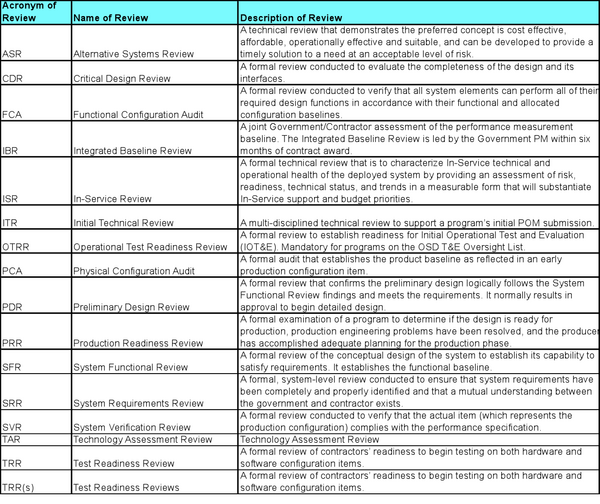Difference between revisions of "Assessment and Control"
(No difference)
|
Revision as of 17:19, 24 June 2011
The purpose of Systems Engineering Assessment and Control (SEAC) is to provide adequate visibility into the project’s actual technical progress and risks with respect to the technical plans (i.e., SEMP and subordinate plans). The visibility allows the project team to take timely preventive action when trends are recognized or corrective action when performance deviates beyond established thresholds or expected values. SEAC includes preparing for and conducting reviews and audits to monitor performance. The results of the reviews and measurement analyses are used to identify and record findings/discrepancies and may lead to causal analysis and corrective/preventive action plans. Action plans are implemented, tracked, and monitored to closure. (NASA 2007, Section 6.7) (SEG-ITS, 2009, Section 3.9.3, 3.9.10) (SEI, 1995, PA11) (INCOSE, 2010, Clause 6.2) (CMMI Product Team, 2006)
SEAC includes determination of appropriate handling strategies and actions for findings and/or discrepancies that are uncovered in the enterprise, infrastructure, or life cycle activities associated with the project, and for initiating the identified actions or replanning. Analysis of the causes of the findings/discrepancies aid in the determination of appropriate handling strategies. Implementation of the approved preventive, corrective, or improvement actions is taken to ensure satisfactory completion of the project within planned technical, schedule, and cost objectives. Potential action plans for findings and/or discrepancies are reviewed in the context of the overall set of actions and priorities in order to optimize the benefits to the project and/or organization. Interrelated items are analyzed together to obtain a consistent and cost effective resolution.
SE Assessment and Control Process Overview
The SE assessment and control process includes the following activities:
- Monitor and review performance and resource usage against plan
- Analyze issues and determine appropriate actions
- Manage actions to closure
The figure below shows major technical reviews used in SEAC.
Major Technical Reviews
Linkages to Other Systems Engineering Management Topics
The project assessment and control process is closely coupled with the Measurement, Planning, Decision Management, and Risk Management processes. The Measurement process provides indicators for comparing actuals to plans. Planning provides estimates and milestones that constitute plans for monitoring, and the project plan with measures used to monitor progress. Decision Management uses the results of project monitoring as decision criteria for making control decisions.
Practical Considerations
Key pitfalls and good practices related to SEAC are described in the next two sections.
Pitfalls
Some of the key pitfalls encountered in planning and performing SE Assessment and Control are:
- Since the assessment and control activities are highly dependent on insightful measurement information, it is usually ineffective to proceed independent of the measurement efforts.
Good Practices
Some good practices gathered from the references are:
- Provide independent (from customer) assessment and recommendations on resources, schedule, technical status, and risk based on experience and trend analysis.
- Document and communicate status findings and recommendations to stakeholders.
- Ensure that action items and action-item status, as well as other key status items, are visible to all project participants.
- When performing root cause analysis, consider root cause and resolution data documented in previous related findings/discrepancies.
- Plan and perform Assessment and Control concurrently with the activities for Measurement and Risk Management.
- Additional good practices can be found in (INCOSE 2010, Clause 6.2), (SEG-ITS, 2009, Sections 3.9.3 and 3.9.10), (INCOSE, 2010, Section 5.2.1.5), (NASA, 2007, Section 6.7).
References
Please make sure all references are listed alphabetically and are formatted according to the Chicago Manual of Style (15th ed). See the BKCASE Reference Guidance for additional information.
Citations
List all references cited in the article. Note: SEBoK 0.5 uses Chicago Manual of Style (15th ed). See the BKCASE Reference Guidance for additional information.
Primary References
INCOSE. 2010. INCOSE systems engineering handbook, version 3.2. San Diego, CA, USA: International Council on Systems Engineering (INCOSE), INCOSE-TP-2003-002-03.2.
NASA. December 2007. Systems engineering handbook. Washington, D.C.: National Aeronautics and Space Administration (NASA), NASA/SP-2007-6105.
SEI. 1995. A systems engineering capability maturity model, version 1.1. Pittsburgh, PA, USA: Software Engineering Institute (SEI)/Carnegie-Mellon University (CMU), CMU/SEI-95-MM-003.
---. 2007. Capability maturity model integrated (CMMI) for development, version 1.2, measurement and analysis process area. Pittsburgh, PA, USA: Software Engineering Institute (SEI)/Carnegie Mellon University (CMU)
Systems Engineering Guidebook for Intelligent Transport Systems. Version 3.0, US Department of Transportation, Federal Highway Administration, 2009.
Additional References
ISO/IEC/IEEE. 2009. Systems and software engineering - life cycle processes - project management. Geneva, Switzerland: International Organization for Standardization (ISO)/International Electronical Commission (IEC)/Institute of Electrical and Electronics Engineers (IEEE), ISO/IEC/IEEE 16326:2009(E).
Glossary
Acronyms
Acronym Definition SEAC Systems Engineering Assessment and Control
SEMP Systems Engineering Management Plan
